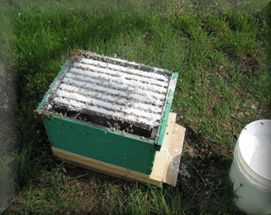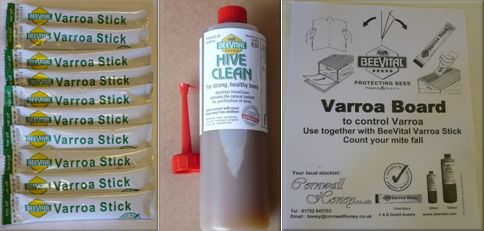Page 1
Page 2
Page 3
Page 4
Page 5
Page 6
Alternative Treatments
Sugar Dusting:
This method requires you to sprinkle castor or light sugar over the bee colony, this is to
promote bee grooming which will cause the mites to fall off and through the wire mesh floor to its death. Needs to be used with a varroa floor to allow for mite drop or the mites will climb back up into the colony.
The down side is you cannot get the mite when there is brood because the mite uses the brood to breed, it only removes the mite on the bees.
There is no chemicals or dangerous effects on the bees, the only problem is you cannot get the sugar dust down through the frames where most of the bees are unless you dust each frame individually.
No scientific data is yet available on the efficiency or success rate of this method.

A sugar-dusted brood
Beevital Hiveclean:
Using this method requires you to trickle Beevital Hiveclean over the middle 7-8 brood frames. The substance is spread by the bees and activates bee grooming, initiating the cleaning instinct of the bees causing them to thoroughly clean themselves and the cells of the dead larvae.
Bees that are weakened or ill due to mite attack will leave the colony and may be observed in front of the hive.
Beevital changes the smell of the bee environment and the mite perception of this situation is that their food source has changed, this irritates the Varroa and they leave their hosts falling onto a sticky floor or through a mesh where they starve to death.
Use Beevital in July/August and again in November/December, but can be used anytime throughout the season including during the honey flow.
Produces no negative effect on the bees, brood or queen and is not a harsh medicine. It is made from natural elements and best results are obtained when used with a varroa floor. Comes in a 500ml bottle or in single-dose sachet sticks. Used by Austrian Organic Beekeepers and becoming increasingly popular in the UK.

Beevital Hiveclean Products
Varroacides and the Law
Use only UK authorised treatments and always follow the manufacturers instructions, making sure that you have reliable up to date information on the legal status of treatments you use.
Keep accurate records of what treatments you use, this is a legal requirement, because you could be requested to provide a sample of your honey for residue analysis.
Good Husbandary Practise:
- Monitor the infestation in your hives regularly.
- Practise integrated pest management using various methods.
- Slow the spread of resistant varroa.
- Use only UK recommended treatments.
- Rotate when possible two or more varrocides.
- Keep up to date with new treatments.
- Select for and retain bees that appear to show tolerance to varroa.
- Keep records of treatments used and when.
Remember!
To prevent the loss or collapse of your bee colonies make regular checks.
If you are going to keep bees look after them and be a conscientious keeper.
These fantastic insects are a very important part of our eco-structure and agriculture.
References: “Managing Varroa” published by the Department for Environment, Food and Rural Affairs (Defra). Some photo's from Richard Ball, CSL National Bee Unit.